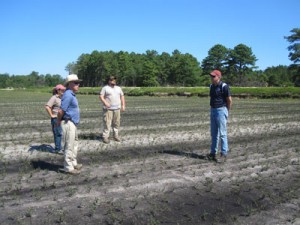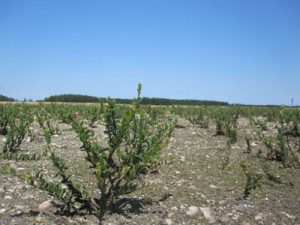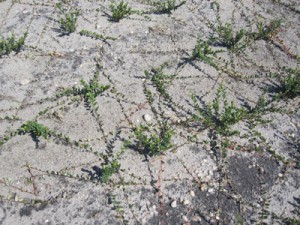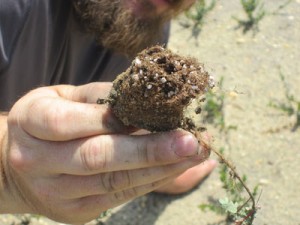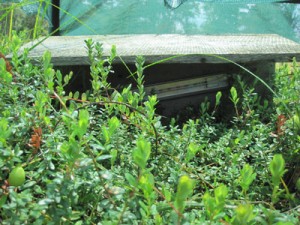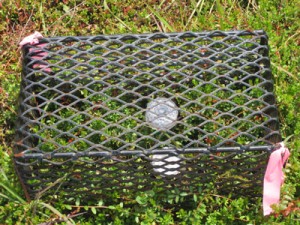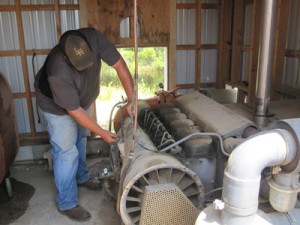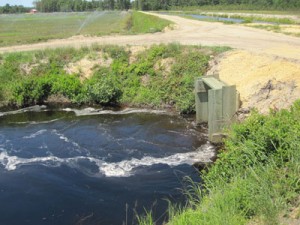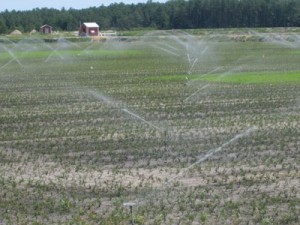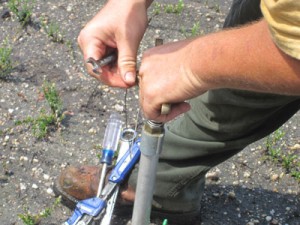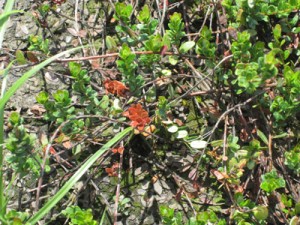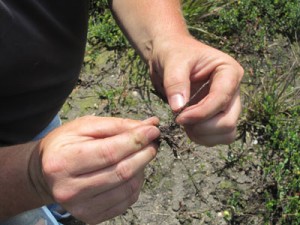One of our April blog entries was on planting bogs at Sim Place. Planting was completed in May, but continuing care for the young bogs is under the supervision of Tug Haines, the fifth generation of the Haines family working at Pine Island and currently serving as a foreman in our PIICM program.
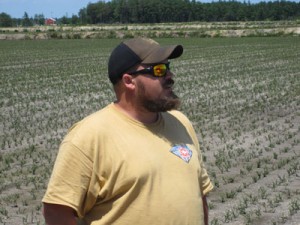
Once the plants are in, it is important to monitor the young bogs frequently to ensure that they are rooting well and remain healthy. Last week, Tug met with Bill, PIICM manager Cristina Tassone, and Dan Schiffhauer of Ocean Spray to check the bogs and discuss their nutritional needs.
The consensus was “so far, so good”; we’re not getting much leaf drop and the plants seem to be thriving. We’re not seeing many runners yet, but according to Schiffhauer, that’s just fine. “You don’t want kudzu,” he says. “The important thing the first year is for the roots to establish before they start running, and that’s what we’re seeing.” The PIICM team will continue to watch color and leaf size on the new growth in order to determine fertilizer needs and then modifying the plan if necessary. As soil and nutrition consultant Dr. Joan Davenport always reminds us: “It is ineffective to put fertilizer onto the beds until the root mass around the [new plants] is at least the diameter of a standard #2 pencil.”
As with the established bogs, heat is also a consideration. A ride with Tug overseeing the young bogs is very much like a night monitoring for frost; we check for the bog temperature (the thermometer is protected by a shade canopy for more accurate readings) and soil moisture before deciding if running the water is necessary.
You cannot always rely on tensiometer readings, however; you also need to get out in the bog and check for yourself. On her last visit, Joan also noted that “when leaves are young and tender, relying strictly on the tensiometers could result in a false sense of security about what the plant water demand is.” Yesterday the soil seemed particularly hardened and dry, so Tug decided to run the water for a couple of hours. Again, as with frost, it’s not just as simple as turning on some sprinklers. Once the irrigation is going, it may also be necessary to let more water in from the reservoirs to keep the pump supplied.
Then, of course, we ride around to monitor both the soil and the equipment in order to fix any possible sprinkler malfunctions. “You have a little more margin for error than you do with frost,” Tug says. “It’s urgent, but you don’t need to move quite as fast.” He needs to make sure the sprinklers are both running at capacity and rotating completely in order to get the best cooling effect.
Even on young bogs, however, maintaining a balance is crucial in order to avoid phytophthora. If it infects and damages the root system, it could take more than one growing season for the bogs to recover.
One of the strategic drivers to achieve our mission is increasing production over time through bog renovation and decreasing the time to achieve full production, which is essential to accomplish our growth objectives. And, like everything else we do here at Pine Island Cranberry, the key to achieving our goals is attention to detail. All of the things on this week’s tour shows our drive to be the very best and the amount of attention to detail that implementing our strategy takes.

